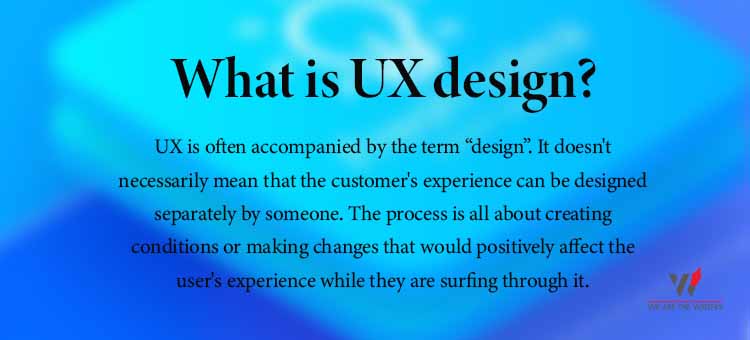You put in a lot of effort in ensuring that the audience likes your content and your website. You work on the marketing, the designs, the content, the SEO, and what not to present the best to the users, with the goal of giving the best user experience.
Your audience has no idea about how you are working on your SEO or marketing, they just understand how easy, descriptive, useful and usable your content is. In a nutshell, this is what you can call user experience.
This is considered one of the most crucial factors for the success of your brand because user experience stays with the audience even when they leave.
You may also like to read:
- All about UI UX | Learn to make your Content Design better in 2022 (wearethewriters.com)
- What is Search Intent ? A Promising factor for Website Ranking on SERPs
What is User Experience?
User Experience is commonly abbreviated into UX and as suggested by the name, the experience of the user is central to the concept. In the simplest words, it is what the user feels in the process of interaction with a website or a software.
Various elements such as the interface, layout, text or visual design, sound etc, influence the user experience. The audience perceives these elements and then decides what the overall user experience is.
UX is an intangible entity. It’s something to experience. The various elements that you incorporate in your content to make it good, collectively design the experience that the user lives while interacting with the app, website or a software.
In its descriptive blog What You Should Know About User Experience Design adobe has mention very clearly about User expirence.
Why is UX important?

The importance of UX can be seen in every sphere of the marketing process. The ultimate goal of growth and development will not be possible without the customers giving positive feedback to what the brand is offering, product or service. It is very much responsible for providing customer satisfaction, exactly what every customer longs for.
Its aim is to facilitate the customer with positive experiences collectively in every part of the interactive process. Be it casually visiting the website or making transactions though it. It can be viewed as the journey of the customer while accessing the system. Good UX improves returns on investments (ROI). It can make the basic products which are not a new innovation, in a manner that is fresh and unconventional thus, offers a new experience to the users.
UX can be the direct takeaway of your customer from the brand. It is what you supply to the customer and a prominent manner of communication.
Organic search marketing capacity is highly influenced by good customer experience and it helps in the website ranking of the SERPs. It is a comparatively newly conceptuated and iterated factor on which google ranks websites but has been around from the very starting.
A good UX answers all the following questions.
- How easy is navigation on your website?
- Is your content engaging enough for your audiences to stay?
- How secure is your site for the users?
The Importance of User Experience – Statistics
- Bad customer experience makes around 79 percent of visitors leave and prefer some other website.
- Users who are accessing the website on a smartphone have 5 times more chances of leaving the website if they face an inconvenience. They also are frequent buyers who have come with transactional intent who might make a purchase on the same day.
- Following a bad experience, a mere 12% of the users stay on the website, the rest 88% make an immediate switch to the next alternative.
- Adobe believes 39 percent of the users will stop engaging with a website if it takes too long to load images.
- Studies have shown that good UX boosts the conversion rates with almost double the percentage as compared to user interface.
Google weighs User Experience as one of the most important website ranking factors. The main reason behind it is that the customer experience sums up all the other factors. The importance of UX has demonstrated why it has become one of the most prioritised factors in Google’s eyes.
For example, the software should be compatible with smartphones. Most of the users who use the app or the software or visit the website will be doing it on their smartphone. It’s different from a computer because the screen size, the mode of interaction and the processors are different.
The users hope for fast, touch stimulated results from these websites while using them on their smartphones which is not the case with doing it on the computer. The size of the screen is alot smaller than the computer’s thus, ads and pop-ups should be avoided as they hinder the overall experience.
A very important leg of User Experience is UX Design.
What is UX design?

UX is often accompanied by the term “design”. It doesn’t necessarily mean that the customer’s experience can be designed separately by someone. The process is all about creating conditions or making changes that would positively affect the user’s experience while they are surfing through it.
UX Design is a process of making products that elevate the customer’s experience.
It depends largely on these factors :
- Usable: The product should be easy to learn and use.
- Useful: The product must be useful. It should serve a purpose. A majority of the buyers will only buy it if it is of some use to them.
- Desirable: the products should be aesthetically pleasing and create a sense of desirability in the audience’s minds.
- Findable: If the user has a problem with a product, they should be able to quickly find a solution.
- Accessible: the accessibility of the product or service is very important. It should be easily accessible on all the prevailing modes of use.
- Credible: The institution and its products should be credible.
The relationship between UX and SEO

The ultimate goal of SEO and User Experience (UX) is to provide a good experience to their audience. With the rather new inclusion of UX in top ranking factors, it has joined SEO in the most interesting topics of this sphere. UX has become one of the best practices of SEO and rightfully so, because of its impact on the other most important website ranking factors.
Tips to follow for better UX that also cater to SEO

- Use smaller paragraphs: using smaller paragraphs will not only help your audience read the content better but also for Google.
- Optimize headings: heading are extremely crucial because they lure the readers to read what is inside of them. Headings serve SEO better than they enhance the UX.
- Use rich media like images and infographics: supporting your text with images has its own perks. Both in the eyes of the reader and Google.
- Image Optimization: create images that include keywords. It strengthens the overall content and increases the possibility of getting the images ranked even if the content falls short.
- Be cautious and informed of the size of the image: images that fail to load are one of the biggest reasons for bad UX.
- Mobile compatibility: almost every user has the option of visiting the website on their mobile devices. Make sure your software runs smoothly on them.
- Cut back on CSS and JavaScript especially third-party scripts.
- Remove CSS and JavaScript that provide functionality for things like sliders and contact forms when those features are not on the page.
- Pay attention to something as simple as a font: using simpler and easily available fonts will be a plus point for your content. Or you can simply use Sans-serif.
You may also like to read :
- 5 SEO Content Writing Tips you wish you got earlier !
- SEO Copywriting vs SEO Content Writing | Learn the difference in 6 minutes
- Complete Beginners Guide to SEO | 8 min read
Wrapping Up
Customer experience is all about providing the best experience to the users who access your website. For doing so, you need to understand all about your customers and provide them everything that they wish for from your brand.
UX and SEO share the common goal of making the user happy by providing the most optimised and wholesome experience.

 WhatsApp
WhatsApp